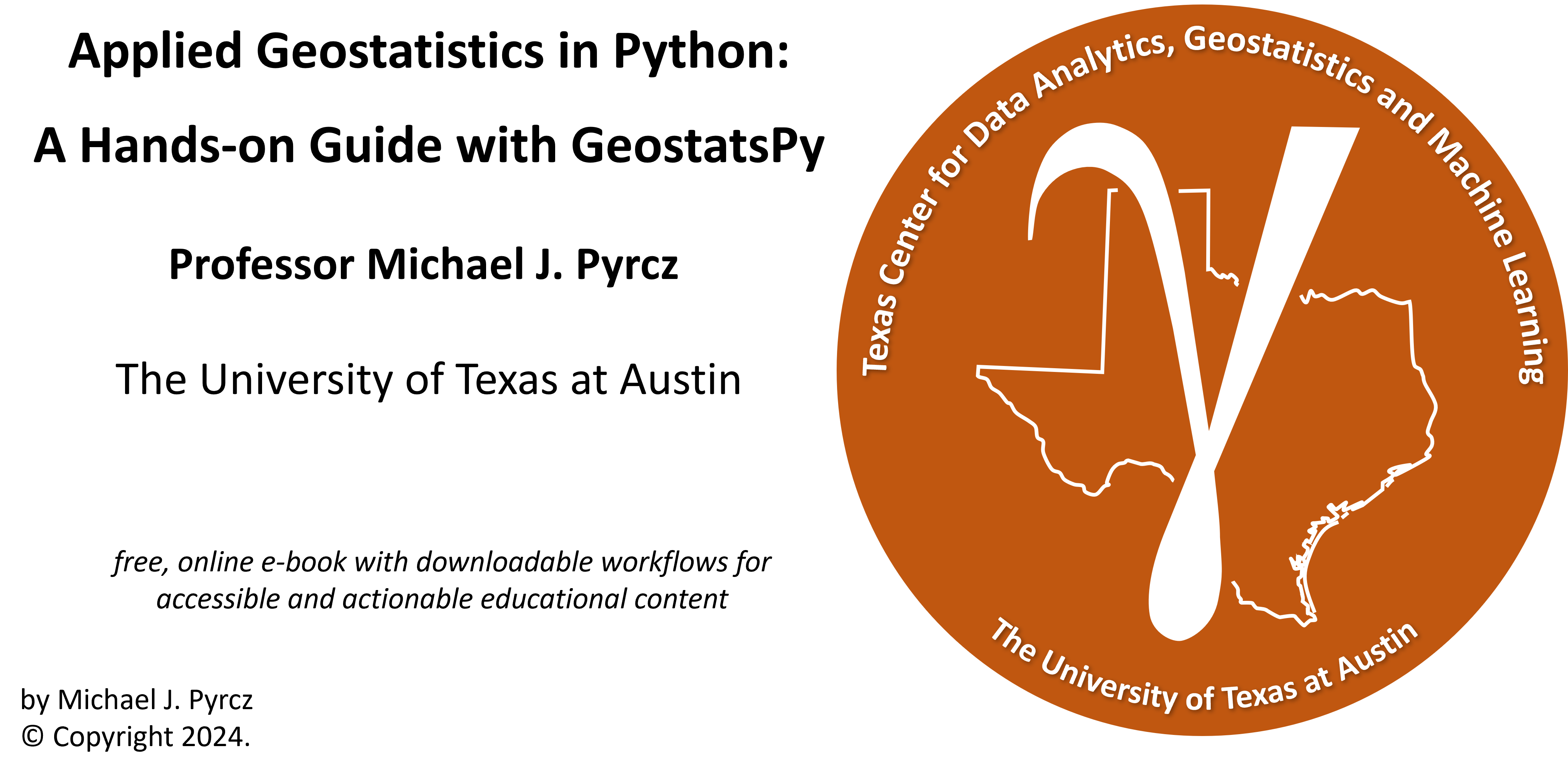
Parametric Distribution Fitting#
Michael J. Pyrcz, Professor, The University of Texas at Austin
Twitter | GitHub | Website | GoogleScholar | Geostatistics Book | YouTube | Applied Geostats in Python e-book | Applied Machine Learning in Python e-book | LinkedIn
Chapter of e-book “Applied Geostatistics in Python: a Hands-on Guide with GeostatsPy”.
Cite this e-Book as:
Pyrcz, M.J., 2024, Applied Geostatistics in Python: a Hands-on Guide with GeostatsPy [e-book]. Zenodo. doi:10.5281/zenodo.15169133
The workflows in this book and more are available here:
Cite the GeostatsPyDemos GitHub Repository as:
Pyrcz, M.J., 2024, GeostatsPyDemos: GeostatsPy Python Package for Spatial Data Analytics and Geostatistics Demonstration Workflows Repository (0.0.1) [Software]. Zenodo. doi:10.5281/zenodo.12667036. GitHub Repository: GeostatsGuy/GeostatsPyDemos
By Michael J. Pyrcz
© Copyright 2024.
This chapter is a tutorial for / demonstration of Parametric Distribution Fitting.
YouTube Lecture: check out my lectures on:
This lecture is part of my Data Analytics and Geostatistics Course on YouTube with linked well-documented Python workflows and interactive dashboards. My goal is to share accessible, actionable, and repeatable educational content. If you want to know about my motivation, check out Michael’s Story.
General Model Fitting#
Using data to infer the parameter distribution parameters is useful to support forecasting and anomality detection. There are multiple methods to accomplish this,
There are two common methods to fit a model, ordinary least squares and maximim likelihood estimation. Here I provide a short description and then demonstrate them together for fitting a parametric Gaussian distribution to a synthetic data set.
First, let’s define the model and data.
The model parameters, \(\beta\), are trained to the training data, \(X_{\alpha}, \alpha = 1,\ldots,n\).
In this example the model is a parametric Gaussian distribution; therefore the model parameters are the mean, \(\mu\), and standard deviation, \(\sigma\).
For this example, the synthetic data are a limited set of independent samples from an ‘unknown’ Gaussian distributions; therefore, we expect that our model selection should be reasonable, i.e., the data is somewhat Gaussian distributed.
Ordinary Least Squares Fitting#
This is a very common method for fitting a model, let’s minimize the error between the model predictions and the observations.
We calculated the model predictions, \(\hat{y}_{\alpha}\), at training data locations, \(\alpha = 1,\ldots,n\).
Then we compare the model predictions to the true data observations as the squared error, \(\Delta y_{\alpha}^2 = \left(\hat{y}_{\alpha} - y_{\alpha} \right)^2\), where the model predictions, \(\hat{y}_{\alpha} = \hat{f}_{\beta}(X_{\alpha})\), are estimated with our estimated model parameters, \(\hat{f}_{\beta}(X_{\alpha})\).
We then sum the squared error over all data observations, the sum of squared error (SSE) is \(\sum_{\alpha=1}^n \left(\hat{y}_{\alpha} - y_{\alpha} \right)^2\)
Now we pose the model parameter estimation problem as an optimization problem to select the model parameters such that we minimize the SSE.
Maximum Likelihood Fitting#
This is a different way to approach fitting a model, find the model parameters, \(\beta\), that maximizes the probability of the sample data, \(X\).
For the Bayesian approach to machine learning, this is the likelihood that is applied to the prior to calculate the posterior. Under the assumption of data independence we apply the product sum to the probability of each of the data, \(X_\alpha = 1,\ldots,n\), given the model:
For our maximization it is sufficient to work with likelihoods, the density values directly from the PDF model, \(\hat{f}_{\beta}(X_{\alpha})\).
This solution can be very small given a large number of sample data, so we commonly apply the log transform to work with the sum of the log likelihoods and we calculate the negative sum of log likelihoods to convert this to a standard minimization problem.
Now we pose the model parameter estimation problem as an optimization problem to select the model parameters such that we minimize the negative log likelihood.
Comparing OLS and MLE Approaches#
We calculate the model parameters, such that we:
OLS: - minimize the sum of the squared differences between the observed values and the values predicted by the model.
MLE: - maximize the likelihood of the observed data given the model.
Both methods assume sufficient sample data, sample data representativity, correct model specification, in adddition:
OLS: - assumes that the errors have a mean of zero, constant variance and are independent of eachother (no correlation in error).
Interactive Python Dashboard#
To demonstrate the parametric distribution fitting, I coded an interactive Python dashboard OLS and MLE Fitting.
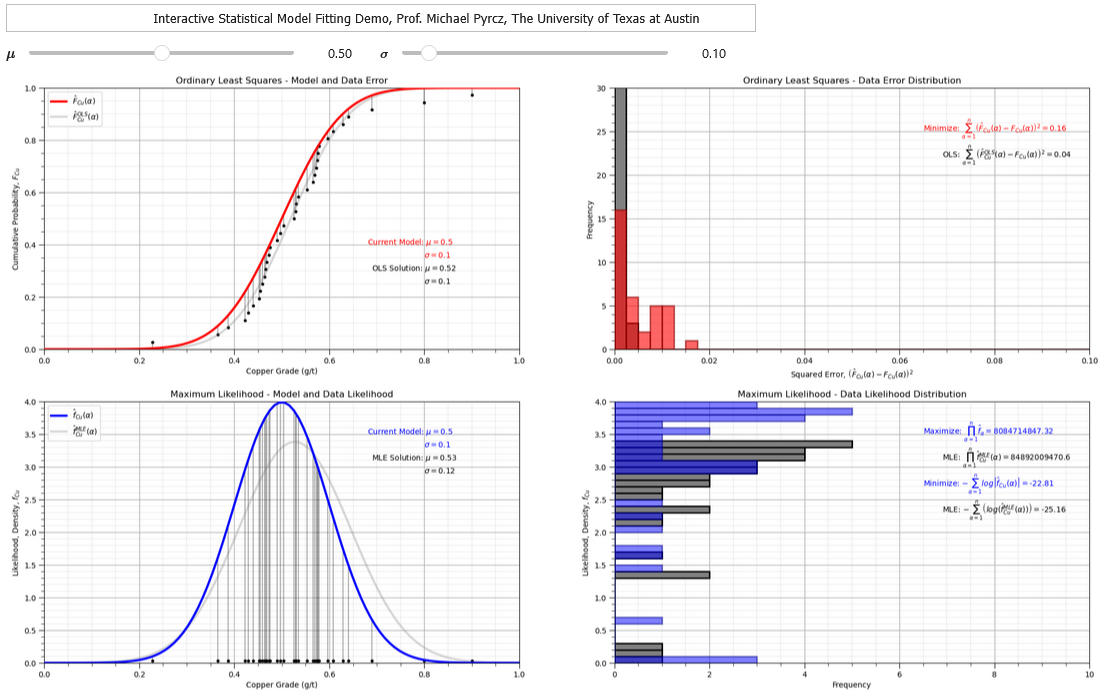
Importing Packages#
We will need some standard packages. These should have been installed with Anaconda 3.
import numpy as np # ndarrys for gridded data
import pandas as pd # DataFrames for tabular data
import os # set working directory, run executables
import matplotlib.pyplot as plt # for plotting
from scipy import stats # summary statistics
import math # trigonometry etc.
import random # for randon numbers
Set the Working Directory#
I always like to do this so I don’t lose files and to simplify subsequent read and writes (avoid including the full address each time).
#os.chdir("c:/PGE383") # set the working directory
Example Guassian Distribution#
Let’s now use the Gaussian parametric distribution.
we assume the parameters, mean and the variance
We will demonstrate the use of the parametric distribution with the forward, \(f_x(x)\) and \(F_x(x)\), and reverse, \(F^{-1}_x(x)\), operations and calculate the summary statistics.
from scipy.stats import norm as my_dist # import traingular dist as my_dist
import numpy as np # ndarrys for gridded data
dist_type = 'Gaussian' # give the name of the distribution for labels
mean = 0.15; stdev = 0.03 # given the distribution par
x_values = np.linspace(0.0,0.3,100) # get an array of x values
p_values = my_dist.pdf(x_values, loc = mean, scale = stdev) # calculate density for each x value
P_values = my_dist.cdf(x_values, loc = mean, scale = stdev) # calculate cumulative probablity for each
plt.subplot(1,3,1) # plot the resulting PDF
plt.plot(x_values, p_values,'r-', lw=5, alpha=0.8); plt.title('Sampling the ' + str(dist_type) + ' PDF, $f_x(x)$'); plt.xlabel('Values'); plt.ylabel('Density')
plt.subplot(1,3,2) # plot the resulting CDF
plt.plot(x_values, P_values,'r-', lw=5, alpha=0.8); plt.title('Sampling the ' + str(dist_type) + ' CDF, $F_x(x)$'); plt.xlabel('Values'); plt.ylabel('Cumulative Probability')
p_values = np.linspace(0.00001,0.99999,100) # get an array of p-values
x_values = my_dist.ppf(p_values, loc = mean, scale = stdev) # apply inverse to get x values from p-values
plt.subplot(1,3,3)
plt.plot(x_values, p_values,'r-', lw=5, alpha=0.8, label='uniform pdf')
plt.subplots_adjust(left=0.0, bottom=0.0, right=3.0, top=1.1, wspace=0.2, hspace=0.3); plt.title('Sampling Inverse the ' + str(dist_type) + ' CDF, $F^{-1}_x(x)$'); plt.xlabel('Values'); plt.ylabel('Cumulative Probability')
print('The mean is ' + str(round(my_dist.mean(loc = mean, scale = stdev),4)) + '.') # calculate stats and symmetric interval
print('The variance is ' + str(round(my_dist.var(loc = mean, scale = stdev),4)) + '.')
The mean is 0.15.
The variance is 0.0009.

Monte Carlo Sample Dataset#
Let’s make a random dataset and then fit it with a Gaussian distribution.
we do \(n\) random samples, Monte Carlo simulations, from the Gaussian parametric distribution with parameters \(mean\) and \(stdev\).
n = 100
samples = my_dist.rvs(size=int(n), loc = mean, scale = stdev, random_state = 73073).tolist() # make a synthetic dataset
plt.subplot(1,2,1) # plot the binned PDF
plt.hist(samples,bins = np.linspace(mean-3*stdev,mean+3*stdev,30), density = True, color = 'darkorange', edgecolor = 'black', alpha = 0.8)
plt.xlim(0.0,0.3); plt.ylim(0,25); plt.xlabel('Values'); plt.ylabel('Density'); plt.title('Normalized Histogram')
plt.subplot(1,2,2) # plot the CDF
plt.hist(samples, bins = len(samples), density = True, color = 'darkorange', edgecolor = 'black', cumulative = True, histtype = 'stepfilled',alpha = 0.8)
plt.xlim([np.min(samples),np.max(samples)]); plt.ylim(0,1); plt.xlabel('Values'); plt.ylabel('Cumulative Probability'); plt.title('CDF')
plt.subplots_adjust(left=0.0, bottom=0.0, right=2.0, top=1.1, wspace=0.2, hspace=0.3)
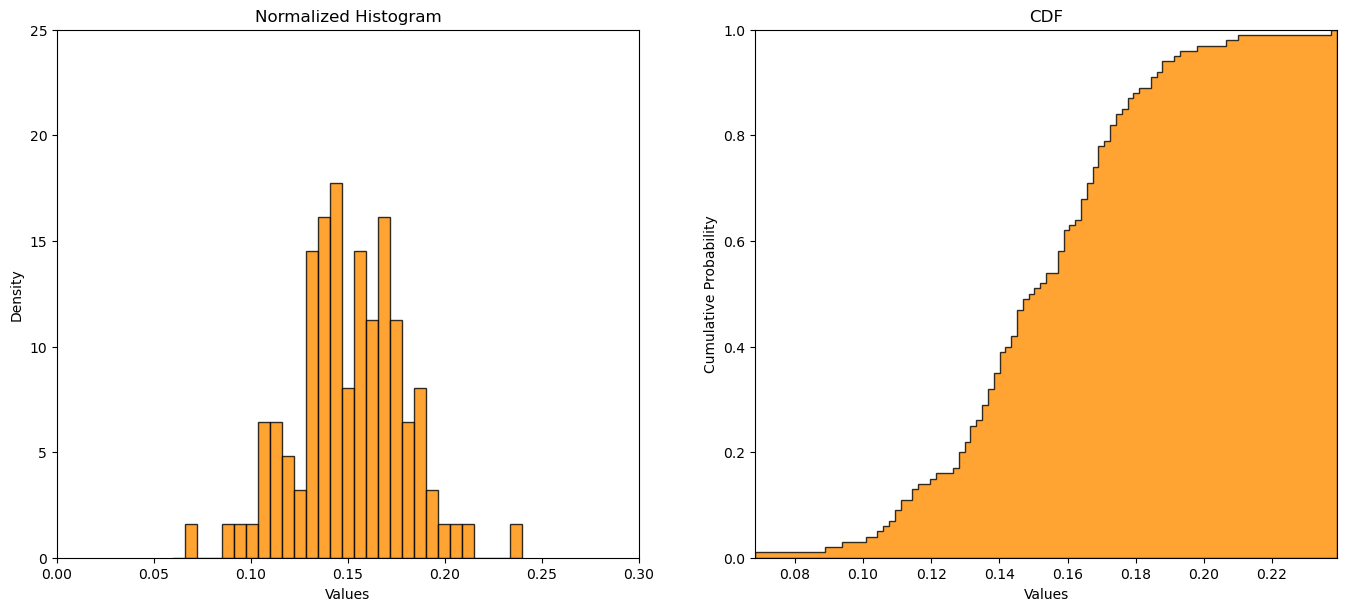
Maximum Likelihood Estimation#
Now we can fit a Gaussian parametric distribution to our dataset by maximum likelihood estimation.
plt.subplot(1,2,1) # plot the binned PDF
plt.hist(samples,bins = np.linspace(mean-3*stdev,mean+3*stdev,30), density = True, color = 'darkorange', edgecolor = 'black', alpha = 0.8)
plt.xlim(0.0,0.3); plt.ylim(0,25); plt.xlabel('Values'); plt.ylabel('Density'); plt.title('Normalized Histogram and MLE Parametric Distribution Fit')
x = np.linspace(my_dist.ppf(0.0001, loc = mean, scale = stdev),my_dist.ppf(0.9999, loc = mean, scale = stdev), 100)
fit_mean, fit_stdev = my_dist.fit(samples,loc = mean, scale = stdev) # fit MLE of the distribution parameters
print('MLE mean = ' + str(round(fit_mean,3)) + ', MLE standard deviation = ' + str(round(fit_stdev,3)))
plt.plot(x, my_dist.pdf(x, loc = fit_mean, scale = fit_stdev), 'black', lw=5, alpha=0.8, label='norm pdf')
plt.xlim(0.0,0.3); plt.ylim(0,25); plt.xlabel('Values'); plt.ylabel('Density')
plt.subplot(1,2,2) # plot the binned PDF with the fit parametric distribution
plt.hist(samples, bins = len(samples), density = True, color = 'darkorange', edgecolor = 'black', cumulative = True, histtype = 'stepfilled',alpha = 0.8)
plt.xlim([np.min(samples),np.max(samples)]); plt.ylim(0,1); plt.xlabel('Values'); plt.ylabel('Cumulative Probability'); plt.title('CDF and MLE Parametric Distribution Fit')
plt.plot(x, my_dist.cdf(x, loc = fit_mean, scale = fit_stdev), 'black', lw=5, alpha=0.8, label='norm pdf') # plot the CDF with the fit parametric distribution
plt.subplots_adjust(left=0.0, bottom=0.0, right=2.0, top=1.1, wspace=0.2, hspace=0.3)
MLE mean = 0.151, MLE standard deviation = 0.028
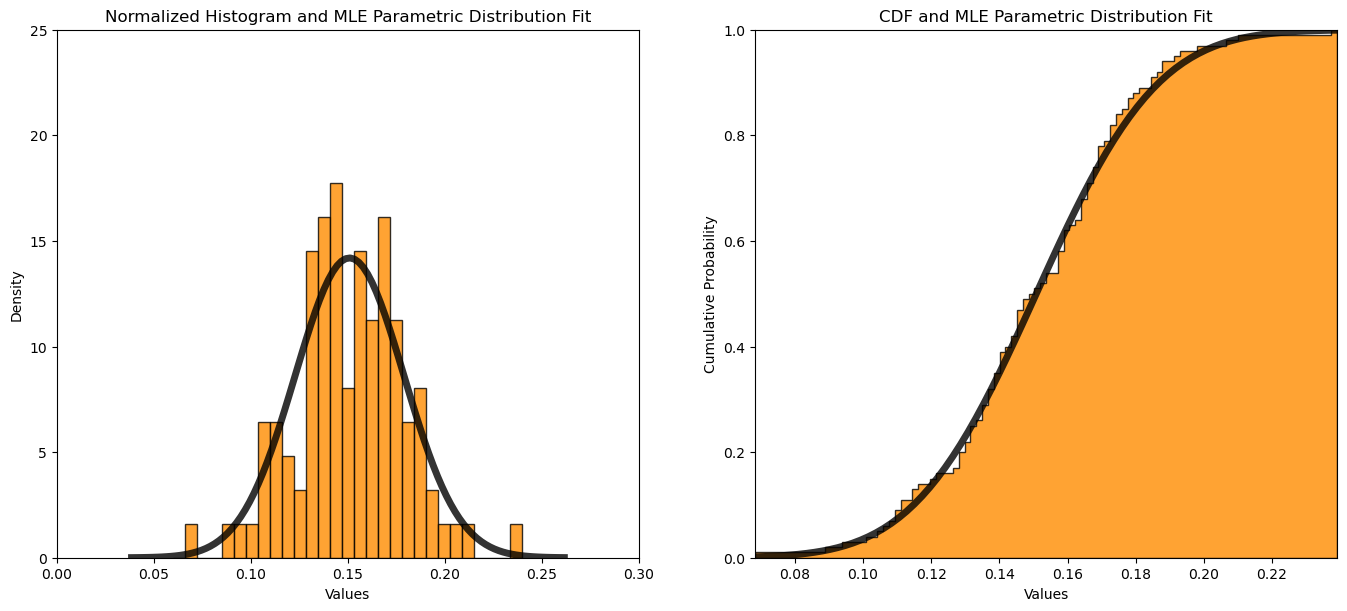
Calculating the Parameters from the Data#
What if we just calculate the mean and standard deviation from the sample data to use as our ‘fit’ parametric distribution?
this may work well if there are no outliers, e.g., if there are a couple very high values the mean would shift up and the over distribution fit would be poor
in this case we get about the same results as the maximum likelihood estimation of the distribution parameters
plt.subplot(1,2,1) # plot the binned PDF
plt.hist(samples,bins = np.linspace(mean-3*stdev,mean+3*stdev,30), density = True, color = 'darkorange', edgecolor = 'black', alpha = 0.8)
plt.xlim(0.0,0.3); plt.ylim(0,25); plt.xlabel('Values'); plt.ylabel('Density'); plt.title('Normalized Histogram and Sample Statistics-based Parametric Distribution Fit')
x = np.linspace(my_dist.ppf(0.0001, loc = mean, scale = stdev),my_dist.ppf(0.9999, loc = mean, scale = stdev), 100)
mean = np.mean(samples); stdev = np.std(samples)
print('Sample data mean = ' + str(round(mean,3)) + ', MLE standard deviation = ' + str(round(stdev,3)))
plt.plot(x, my_dist.pdf(x, loc = mean, scale = stdev), 'black', lw=5, alpha=0.8, label='norm pdf')
plt.xlim(0.0,0.3); plt.ylim(0,25); plt.xlabel('Values'); plt.ylabel('Density')
plt.subplot(1,2,2) # plot the binned PDF with the fit parametric distribution
plt.hist(samples, bins = len(samples), density = True, color = 'darkorange', edgecolor = 'black', cumulative = True, histtype = 'stepfilled',alpha = 0.8)
plt.xlim([np.min(samples),np.max(samples)]); plt.ylim(0,1); plt.xlabel('Values'); plt.ylabel('Cumulative Probability'); plt.title('CDF and Statistics-based Parametric Distribution Fit')
plt.plot(x, my_dist.cdf(x, loc = mean, scale = stdev), 'black', lw=5, alpha=0.8, label='norm pdf') # plot the CDF with the fit parametric distribution
plt.subplots_adjust(left=0.0, bottom=0.0, right=2.0, top=1.1, wspace=0.2, hspace=0.3)
Sample data mean = 0.151, MLE standard deviation = 0.028
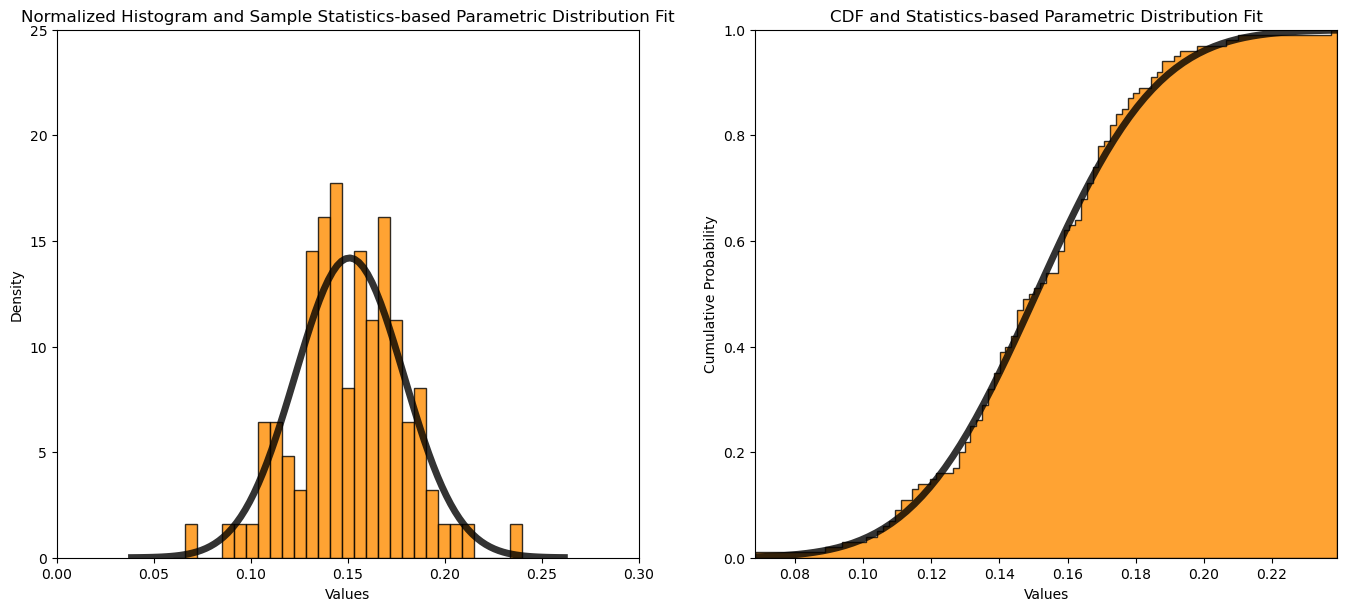
There are many other parametric distributions that we could have included, but I have met my goal of providing a concise demonstration of distribution fitting.
Want to Work Together?#
I hope this content is helpful to those that want to learn more about subsurface modeling, data analytics and machine learning. Students and working professionals are welcome to participate.
Want to invite me to visit your company for training, mentoring, project review, workflow design and / or consulting? I’d be happy to drop by and work with you!
Interested in partnering, supporting my graduate student research or my Subsurface Data Analytics and Machine Learning consortium (co-PI is Professor John Foster)? My research combines data analytics, stochastic modeling and machine learning theory with practice to develop novel methods and workflows to add value. We are solving challenging subsurface problems!
I can be reached at mpyrcz@austin.utexas.edu.
I’m always happy to discuss,
Michael
Michael Pyrcz, Ph.D., P.Eng. Professor, Cockrell School of Engineering and The Jackson School of Geosciences, The University of Texas at Austin
More Resources Available at: Twitter | GitHub | Website | GoogleScholar | Geostatistics Book | YouTube | Applied Geostats in Python e-book | Applied Machine Learning in Python e-book | LinkedIn
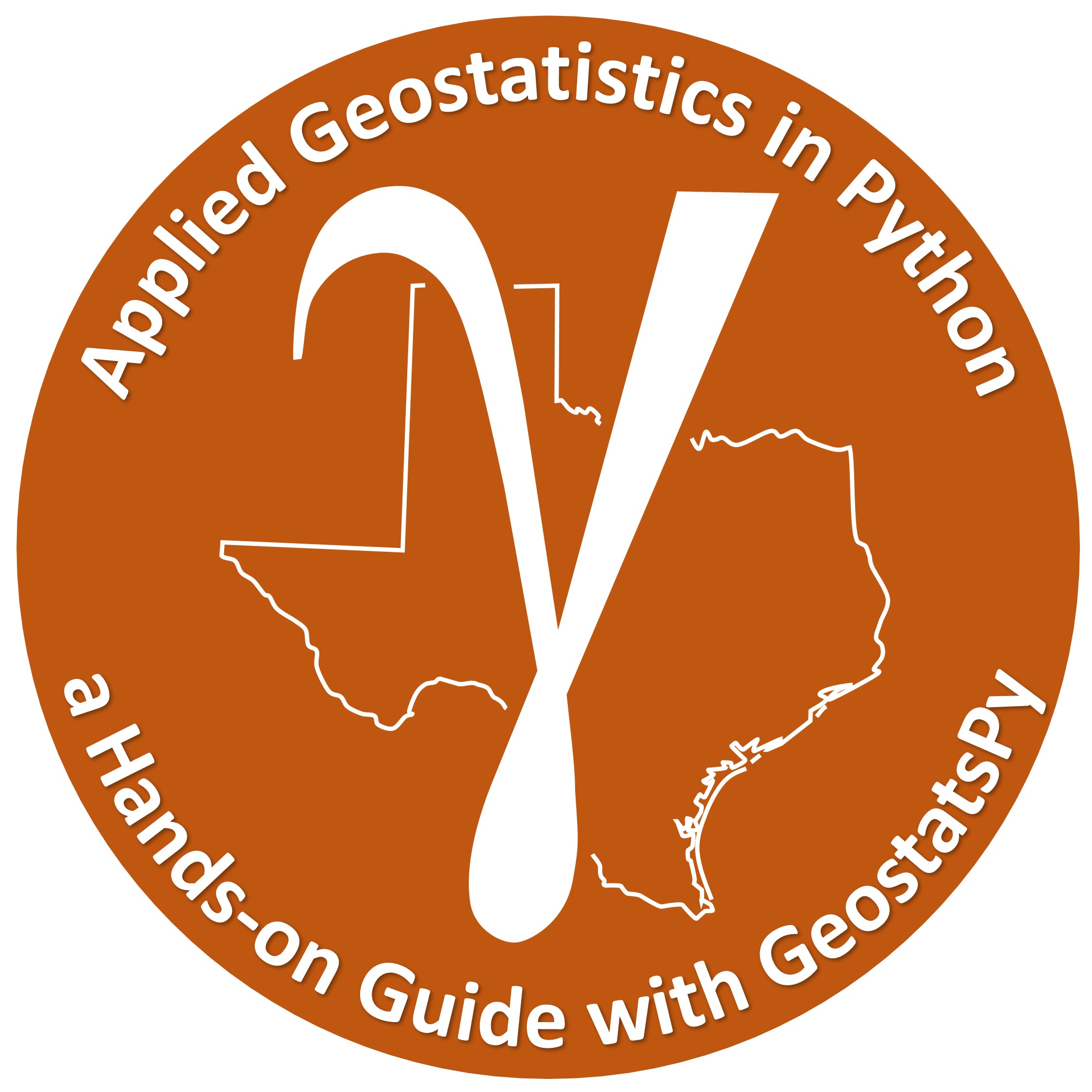

Comments#
I hope you found this chapter helpful. Much more could be done and discussed, I have many more resources. Check out my shared resource inventory,
Michael